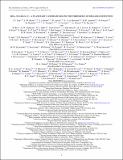MOA-2010-BLG-311: A PLANETARY CANDIDATE BELOW THE THRESHOLD OF RELIABLE DETECTION
Author(s)
Polishook, David; Bowens-Rubin, Rachel; Bennett, C. S.
DownloadYee-2013-MoA-2010-BLG-311_ A.pdf (1.204Mb)
PUBLISHER_POLICY
Publisher Policy
Article is made available in accordance with the publisher's policy and may be subject to US copyright law. Please refer to the publisher's site for terms of use.
Terms of use
Metadata
Show full item recordAbstract
We analyze MOA-2010-BLG-311, a high magnification (A [subscript max] > 600) microlensing event with complete data coverage over the peak, making it very sensitive to planetary signals. We fit this event with both a point lens and a two-body lens model and find that the two-body lens model is a better fit but with only Δχ[superscript 2] ~ 80. The preferred mass ratio between the lens star and its companion is q = 10[superscript –3.7 ± 0.1], placing the candidate companion in the planetary regime. Despite the formal significance of the planet, we show that because of systematics in the data the evidence for a planetary companion to the lens is too tenuous to claim a secure detection. When combined with analyses of other high-magnification events, this event helps empirically define the threshold for reliable planet detection in high-magnification events, which remains an open question.
Date issued
2013-05Department
Massachusetts Institute of Technology. Department of Earth, Atmospheric, and Planetary Sciences; Massachusetts Institute of Technology. Department of PhysicsJournal
The Astrophysical Journal
Publisher
IOP Publishing
Citation
Yee, J. C., L.-W. Hung, I. A. Bond, W. Allen, L. A. G. Monard, M. D. Albrow, P. Fouque, et al. “MOA-2010-BLG-311: A PLANETARY CANDIDATE BELOW THE THRESHOLD OF RELIABLE DETECTION.” The Astrophysical Journal 769, no. 1 (May 6, 2013): 77. © 2013 The American Astronomical Society
Version: Final published version
ISSN
0004-637X
1538-4357